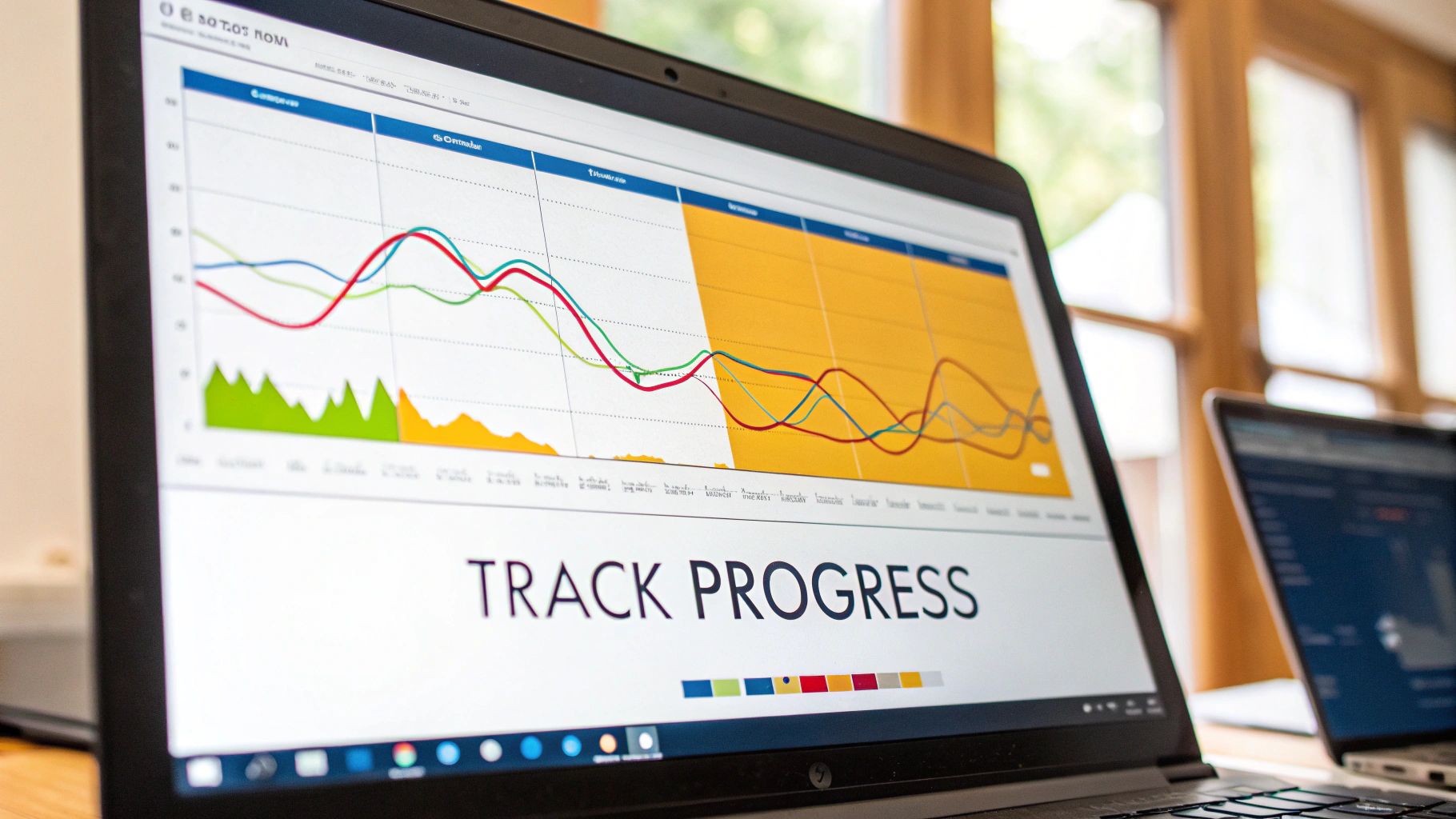How to Measure Project Success

For ages, we measured project success with a simple checklist: Did it finish on time? Did it stay on budget? Did it deliver everything we asked for? But sticking to those old rules—the classic "iron triangle"—is like judging a chef on how quickly they cooked, not how the food actually tasted.
This approach is fundamentally flawed because it misses the whole point of a project.
Why the Iron Triangle Is Rusting

Let's be real. A project can tick all three boxes—scope, time, and cost—and still be a total dud. I’ve seen it happen.
Imagine a team works nights and weekends to launch a new software feature. They deliver it a week early, come in under budget, and every single requirement is met. By the iron triangle’s standards, it’s a massive win. But what if customers ignore it? Or worse, what if it makes their workflow more complicated?
In that scenario, the project didn't actually do anything. It didn't solve a problem or create value. This is where the old model falls apart. It completely ignores the most important questions:
- Did we actually fix the business problem we set out to solve?
- Are the people who have to use this thing—our customers, our internal teams—genuinely happy with it?
- Did this project move us closer to our big-picture company goals?
True success isn't just about delivering outputs. It’s about achieving meaningful outcomes. The real win is when your project makes a tangible, positive change, whether that’s growing revenue, making a process more efficient, or delighting your customers.
Making this mental shift from outputs (the what we built) to outcomes (the what changed because of it) is the key.
This isn't just a philosophical debate; the numbers back it up. Globally, a staggering 48% of projects are considered successful. That means more than half are falling short, likely because they’re chasing the wrong targets.
As technology evolves, so do our methods for tracking success. Many teams are now looking into AI in Project Management to find smarter ways to measure what truly matters.
Let's walk through how to build a framework that ensures your projects don't just get finished—they actually make an impact.
Defining What Success Actually Looks Like

Before a single line of code is written or a single task is assigned, your team needs a crystal-clear answer to one question: What does "done and successful" actually mean for this project? I’ve seen too many projects go off the rails because everyone had a slightly different idea of the finish line.
Defining success isn't about fuzzy aspirations like "improve user experience." It's about getting the entire team, from the executive suite down to the front-line developers, to agree on a specific, unified vision. This alignment is your bedrock. Without it, you’re just building features in the dark, hoping they stick. True success is always tied back to the bigger picture of defining value creation for the company.
From Vague Ideas to Concrete Goals
So, how do you get there? The best tool I've found for this is the classic SMART framework. It’s been around forever for a reason—it works. It forces you to translate abstract ideas into goals that are Specific, Measurable, Achievable, Relevant, and Time-bound.
Let's look at how this plays out in the real world:
For a Software Launch: A goal like "get more users" is useless. A SMART goal sounds like this: "Achieve 10,000 active users and a 15% free-to-paid conversion rate within the first 90 days of launch." See the difference? Now you have actual numbers to track.
For a Marketing Campaign: "Boost brand awareness" is a common but weak objective. Instead, aim for: "Increase organic search traffic by 20% and generate 500 marketing qualified leads (MQLs) from the campaign in Q3."
This isn't just about being precise for the sake of it. This level of clarity has a massive impact on whether you succeed or fail. The data backs this up: a staggering 92% of organizations with formal project management processes hit their goals.
My Pro Tip: Run an alignment workshop right at the start. Get every key stakeholder in a room—virtual or physical—and hash it out. Don't let anyone leave until you have a documented list of success criteria that everyone has agreed to. This one meeting can save you months of pain and rework down the road.
This initial work is tightly connected to defining your project's boundaries. To make sure your goals are realistic and achievable from day one, take a look at our guide on how to define project scope.
Choosing Metrics and KPIs That Matter

Once you've nailed down what success looks like, it’s time to pick the right Key Performance Indicators (KPIs) to measure it. Think of KPIs as the specific, hard numbers that prove you’re on track. Without them, you’re just guessing.
The biggest trap here is getting distracted by vanity metrics. These are the numbers that look great in a presentation but don't actually mean anything for the business. A spike in social media likes feels good, but did it bring in a single new customer or boost revenue? Probably not.
Your focus should be on actionable metrics—data that ties directly to your project goals. If your goal is to build a loyal customer base, tracking your Net Promoter Score (NPS) will tell you a lot more than just website traffic ever could.
A Mix of Numbers and Nuance
I've seen too many projects fail because the team was obsessed with numbers and completely ignored the human side of things. The best approach is to build a balanced view by tracking both quantitative and qualitative data. This gives you the full story.
Quantitative KPIs: These are your classic, numerical metrics. They're objective and easy to track over time. Think Customer Acquisition Cost (CAC), conversion rate, or monthly recurring revenue (MRR).
Qualitative KPIs: These capture how people feel. You'll need surveys or direct feedback to get them, but the context they provide is priceless. Examples include customer satisfaction (CSAT) scores, team morale ratings, or stakeholder feedback.
Imagine your user base grows by 20% (a quantitative win), but your CSAT score plummets by 15% (a qualitative warning sign). That’s a critical insight you’d miss if you only looked at the growth number.
A project isn’t truly successful unless it hits its targets and makes a positive impact on the people involved—from your customers right back to your own team.
Shifting from Outputs to Outcomes
In the past, project success was often judged by simple outputs: Did we finish on time and on budget? While important, that's a very narrow view. Today, the focus has shifted to outcomes—the real-world value the project delivered.
Here’s a look at how that thinking has evolved across different types of projects:
| Project Type | Traditional Metric (Output-Focused) | Modern Metric (Outcome-Focused) |
|---|---|---|
| Software Development | Number of features shipped | User adoption rate, customer lifetime value (CLV) |
| Marketing Campaign | Website traffic, impressions | Lead-to-customer conversion rate, marketing-influenced revenue |
| Process Improvement | Project completed on schedule | Reduction in process cycle time, decrease in error rates by 40% |
| Product Launch | Launch date met | First-month active users, Net Promoter Score (NPS) |
As you can see, the modern approach is all about connecting project work to tangible business results. It’s not just about what you did, but what difference it made.
Taking a Wider View
Top-performing organizations get this. They don't just track a few basic metrics; they look at success from multiple angles. A PwC survey revealed that the top 10% of organizations use an average of 10 different project success measures, while typical companies only use seven. This broader perspective helps them understand the full impact of their work.
This means looking beyond the immediate financial return to consider customer impact, team health, and long-term strategic alignment. For a deeper dive into this, I recommend exploring different frameworks for measuring success with key metrics and KPIs, as the principles apply to nearly any project. It’s about building a measurement system that truly reflects the value you’re creating.
Building Your Data Collection System

Even the most powerful metrics are useless if the data behind them is a mess—scattered across a dozen different spreadsheets and out-of-date reports. If you want to get a real handle on project performance, you need a solid system to collect, track, and analyze your KPIs without a ton of manual grunt work. The goal here is to create a single source of truth, a central hub where everyone on the team can find the same, up-to-date information.
The good news is you don’t have to build this from the ground up. Plenty of tools out there can automate the heavy lifting. Project management software like Asana or Jira is great for tracking task completion and timelines. For qualitative feedback like CSAT or NPS scores, platforms like SurveyMonkey or Typeform are perfect. If you’re working on a user-facing product, analytics tools are your best friend for understanding engagement and behavior. The trick is to get these systems talking to each other so the data flows automatically.
Establishing a Rhythm for Review
Collecting data is just one piece of the puzzle. You also have to create a consistent rhythm for actually looking at it. Regular reviews are what turn raw numbers into actionable insights, helping you spot trends, catch risks before they become disasters, and make decisions based on evidence, not just gut feelings.
Your data collection system should make it easy to answer the question, "Are we on track?" at any given moment. If you have to spend hours digging through emails and reports to find an answer, your system is broken.
A simple, effective approach is to match your review cadence to the type of metric you're tracking.
Weekly Check-ins: This is perfect for the fast-moving operational stuff—think tasks completed, active user logins, or the number of help desk tickets. These meetings should be quick, focused, and geared toward clearing immediate roadblocks.
Monthly or Quarterly Deep Dives: Save these longer sessions for your big-picture, strategic KPIs. This is where you dig into trends for things like customer lifetime value, market share growth, or overall project ROI and make larger strategic adjustments.
By setting up this kind of dual cadence, you create a system that keeps the project on course day-to-day while also ensuring it stays aligned with the bigger business goals. It's a foundational part of truly knowing how to measure project success.
Talking About Project Performance with Stakeholders
You can gather all the data in the world, but it's useless if you can't tell a compelling story with it. How you communicate your project's progress is just as important as the progress itself. Why? Because for stakeholders, perception is reality.
The highly detailed, task-by-task report that your development team loves will put an executive board to sleep in minutes. You have to adapt your message.
Know Your Audience, Nail Your Delivery
Before you even think about building a dashboard or a slide deck, stop and ask a simple question: "Who am I talking to, and what do they actually care about?" The answer changes everything.
Your Project Team: These are the people in the trenches. They thrive on the nitty-gritty details. Think visual tools like burn-down charts that track work completed against the clock or Kanban boards that instantly show where the bottlenecks are. The goal here is to keep the project's day-to-day operations healthy.
Your Executive Leadership: They operate at 30,000 feet. Forget individual tasks; they want to see the bottom-line business impact. Your report for them should scream value, highlighting KPIs like Return on Investment (ROI), Customer Acquisition Cost (CAC), and how the project is moving the needle on major company goals.
Every stakeholder is listening for the answer to one silent question: "So what?" Your job is to answer it for them, directly and without jargon. Draw a straight line from what the project accomplished to what they value most, whether that's revenue, cost savings, or a competitive edge.
Finally, be honest. Nothing kills your credibility faster than trying to hide a problem. Don't be afraid to share setbacks, but frame them as lessons learned and always come to the table with a solution or a plan of action. This approach builds trust and shows you're proactively managing challenges.
This level of transparency also has a huge impact on how you manage your team and budget. For a deeper dive, check out our guide on effective project manager resource allocation to learn how to handle those conversations.
Frequently Asked Questions About Measuring Project Success
Even with the best plan, you're bound to run into some tricky situations when you start measuring project success. Let's walk through a couple of the most common questions that trip up project managers.
How Often Should I Be Measuring Our Progress?
There’s no magic number here—it really comes down to the rhythm and complexity of your project. If you're running a fast-paced agile project, you'll want to check in on your operational metrics weekly, or at the very least, bi-weekly. This quick feedback loop keeps everyone pulling in the same direction on short-term goals.
For the bigger picture stuff, like your strategic KPIs, a monthly or quarterly review makes more sense. This gives you enough time for meaningful trends to actually emerge from the data, so you're not just reacting to random daily fluctuations.
The real goal is consistency. You want to use this data to make smart, timely adjustments along the way, not just to write a report once everything is over.
The biggest trap I see managers fall into is measuring everything constantly. Instead, pick a handful of vital metrics and review them at a sensible pace. The aim is to find actionable insights, not drown your team in data.
What if We Hit Our Goals but Stakeholders Are Still Unhappy?
This is a tough spot to be in, and it almost always points back to a misalignment in the initial success criteria. A project can be a technical masterpiece, hitting every single target, but if it doesn't solve what stakeholders thought it would solve, it's a failure in their eyes. This is exactly why stakeholder satisfaction needs to be one of your core metrics from day one.
If you find yourself here, the only way forward is a candid post-project review. Get in a room with the unhappy stakeholders and have an honest conversation to pinpoint where the disconnect happened. These discussions can be uncomfortable, but they are pure gold for learning how to define success more collaboratively on future projects. A big part of our job is managing expectations and spotting these kinds of risks early. In fact, a good grasp of software project risk management principles can help you sidestep these very problems before they start.